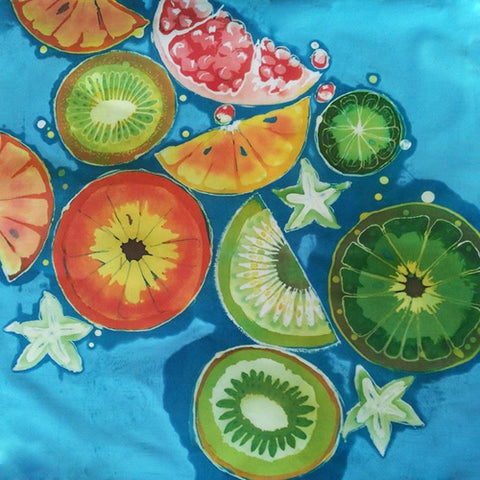I don’t know about you, but thanks to years of being in school followed by forever being surrounded by children and teachers, Autumn will always signal the beginning of my year and a time to learn something new. This year’s September-knowledge-thirst led me to a weekend-long batik course run by Noel Dyrenforth in Hove.
The course was organised by Angela Lenman and was full of passionate batik artists, all with more skill and experience than I…
Over the weekend we worked on three batiks, using a variety of traditional and more experimental techniques. Below are some pictures I snapped along the way to give you a feel of what we got up to.
First we drew our designs onto cotton and stretched it onto frames. I used a
castellated frame as it meant I didn’t have to make one the right size (it also was a little easier carting it on the train from Chichester)!

We used Procion MX Dyes mixed with soda ash to fix the dye. Here is the fabric after the first layer of turquoise dye:

We used a blend of beeswax and paraffin wax which gives you the right amount of crackle whilst staying smooth. Here is my first batik after the next layers of waxing and dyeing:

As it turns out, making a batik has a lot to do with being patient. If you put the hot wax onto dye that is not completely dry it will not penetrate the fabric and wont resist the next layer of dye properly. Thank goodness for cold hairdryers and cups of tea.

The last layer of dye after a final hefty waxing.

We all used Tixor Malam Batik Pots (Guild members were bringing them in by the box-full) which seemed just the right size for a honey coloured pool of wax that lasted the entire weekend.

The second batik we worked on gave us the opportunity to play with a lovely range of Procion MX Dye colours.

Throughout the weekend we used a variety of tools to apply the wax; from Javanese Tjantings to kitchen roll and decorators brushes (natural bristles only unless you want to end up with a melted plastic blob on the end of a stick). One batik artist even broke out a Kistka in order to achieve even more detail whilst we all ooh-ed and aah-ed.

I was particularly proud of this juicy looking pomegranate, drawn with a Size 1 Tjanting:

We ironed the batiks between sheets of newspaper to remove most of the wax, but they will need to be dry cleaned or boiled to remove the rest. The dark blue marks around the fruit below are where the ironed wax has melted and spread and will disappear after the fabric has been cleaned.

Etching into the wax was another technique that was new to me – using a tool to scratch into the wax creates details that the final layer to dye can pick up.

Below is a batik created by a fellow batik enthusiast – far from the fiddly white-outlined paintings often associated with batik!

My final splashy, dynamic batik, created by splattering and brushing on wax between four layers of dye.

The weekend’s most important lesson from Noel: If you’re wondering whether to create movement, dynamism and expression with wax or dye, it should always come from the wax.
Lesson learned.
If you fancy having a go yourself, information about the Batik Guild can be found here and lots of lovely batik supplies can be found on our website.
